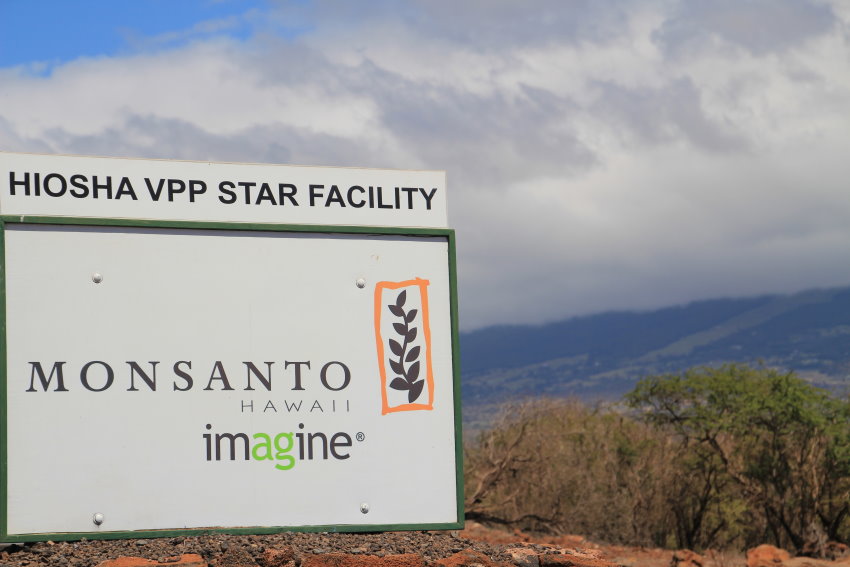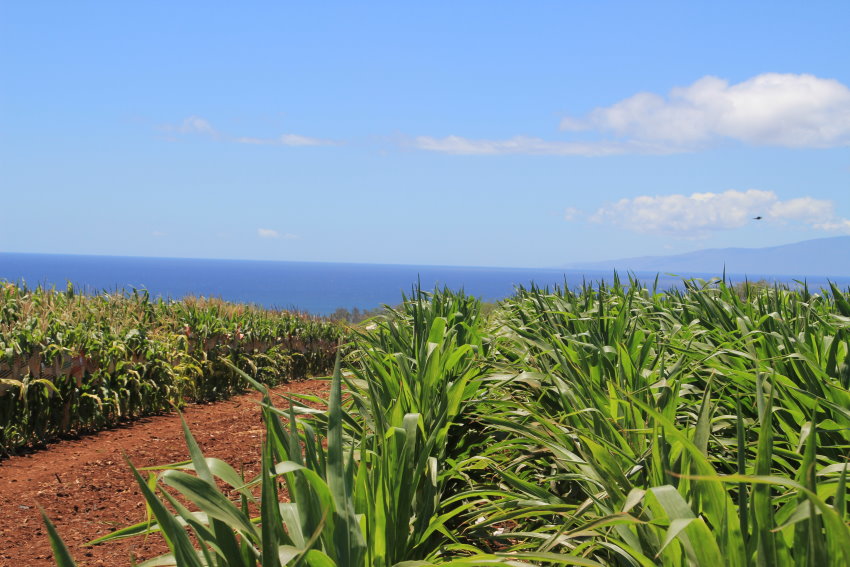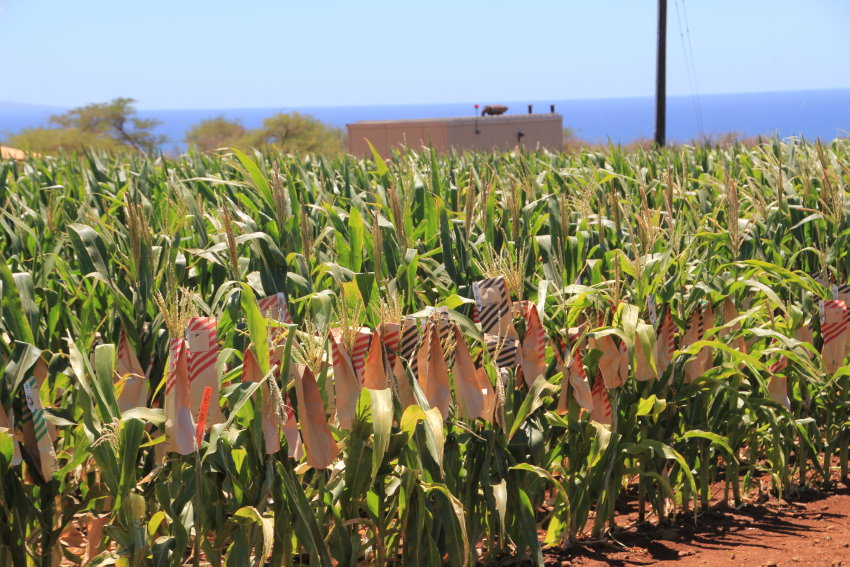
Agricultural News
Hawaii Helps Monsanto and Other US Seed Companies Speed New Traits to Farmers
Tue, 03 Sep 2013 02:14:57 CDT
 Monsanto has a secret weapon when it comes to pushing new traits that are "stacked" onto one another in their corn hybrids- and that secret is found on the dry side of the island that many people believe is the "coolest" place to spend time when they travel to our 50th state. That weapon is based in the Maui community of Kihei- with desolate lava land that has been reclaimed by seed companies for years. One plot that Monsanto now operates on Maui has it roots in Trojan Seeds- where they started seed breeding efforts in the late 1960s. The main research facility for Monsanto and their lineup of DeKalb seeds was established in the early 1990s- and is just a couple of miles straight up from one of the prime beaches on this resort island paradise.
Monsanto has a secret weapon when it comes to pushing new traits that are "stacked" onto one another in their corn hybrids- and that secret is found on the dry side of the island that many people believe is the "coolest" place to spend time when they travel to our 50th state. That weapon is based in the Maui community of Kihei- with desolate lava land that has been reclaimed by seed companies for years. One plot that Monsanto now operates on Maui has it roots in Trojan Seeds- where they started seed breeding efforts in the late 1960s. The main research facility for Monsanto and their lineup of DeKalb seeds was established in the early 1990s- and is just a couple of miles straight up from one of the prime beaches on this resort island paradise.
The picture above shows the Monsanto Hawaii sign that greets visitors as they pull into the Kihei location- and you can tell just beyond the sign how dry and unproductive the land clearly is. But according to top Monsanto official in Hawaii, David Stoltzfus, that suits the biotech leader just fine. Stoltzfus gave Farm Director Ron Hays a personal tour and told him that they use the soil only as a medium to grow the corn plants in- they expect to get no nutrients or moisture from the soil- it all is provided to the plants thru drip irrigation.
The corn being grown in Hawaii by Monsanto is not designed to win a blue ribbon at the local county fair- but rather is designed to advance to the next generation- stacking one or more traits coming from a male tassle and hand delivered to the female corn silk- hoping to produce very quickly a rather poor looking ear of corn that can give him fifty or sixty kernels of this next generation that has as pure as is possible the stacked trait and the characteristics of the female plant thgat produced the ear.
That ear is dried down- and with identity perserved- the seeds are "chipped"- Stoltzfus called this a major advantage that Monsanto has on their competitors- as they can ship that seed to the Mainland US- it is chipped and the DNA sample is run- and then only the seeds with the best chance of delivering the exact response that the plant breeders want will be shipped back to Hawaii- planted in a peat moss medium in a green house and started- when that plant is just a few days old- another DNA sample is collected and it is again run on the US mainland- and the Hawaiian breeders are told which plants are worth taking to the field and which to discard- so instead of perhaps a thousand seeds that have been collected in the process that took about 100 days to grow in that first generation- only a few dozen at the most may pass the double DNA testing to be worthy to be grown in the abundant Hawaiian sun.
Stoltzfus says that means a multi stacked corn hybrid may be ready in just a couple of years- instead of five to eight years.
Why Hawaii? Stoltzfus says that the research facility on Maui gets very few rainy days- and nothing that resembles cold weather. So, it's expected that three generations or a little more can be greeding effortsrown in a single year. With the biotechnology factor added in- the fact that Hawaii is a part of the United States makes makes regulation much easier than in Central America or in any other foreign country.
Monsanto's Site Leader was proud to point out that they can now move a lot more research forward- working with multiple traits compared to just a single trait or perhaps two eight to ten years ago- and are able to do it on less land than ever before in their Hawaiian operations.
The pictures below show that the breeding work in the field is really not that much different than what has been done for decades- with the Pacific Ocean in the background- you can see corn plants that are perhaps six feet tall- and will not get any bigger- the bags over the tassles and the corn silk are moved around to make sure that the correct trait from tassle is moved to the corn silk. What is different from the "good old days" of corn research- the amount of information that can be tracked and the number of steps that can be tracked with computers with the aid of GPS.
Stoltzfus says that the corn breeding business is one of the largest segments of today's Hawaiian agriculture- even though it is not one that tourists ever see. Monsanto employs close to 1,000 employees- with about 800 of them fulltime- across three islands. The seed breeding business provides more than $247 million in direct spending in Hawaii as it provides almost a quarter of agriculture jobs on the islands.
There are vocal opponents to modern production agriculture in Hawaii- but Stoltzfus believes that the GMO argument is getting stale and that activists in the state are focusing more on the use of pesticides- and attempting to use a fear factor with the public about the need to have more regulatory oversight of all aspects of production agriculture- GMO labeling and local monitoring of all breeding efforts that might involve biotechnology, more regulation of pesticides and again local disclosure about when any pesticide is used for any purpose.
There is a move on Kauai to attempt to have more regulation at the county level (the island of Kauai is considered a county within the state) and that has all of modern agriculture worried across the state. While Monsanto does not have any operations on Kauai- most of the other major agri business companies do- so it's a matter of concern what is being talked about at the local level on what is called the "Garden Isle."
We will tell you more about the battle on Kauai later this week as we conclude our time in Hawaii on Kauai.
In the meantime- you call learn more about Monsanto efforts in Hawaii by clicking here.


WebReadyTM Powered by WireReady® NSI
Top Agricultural News
More Headlines...



















